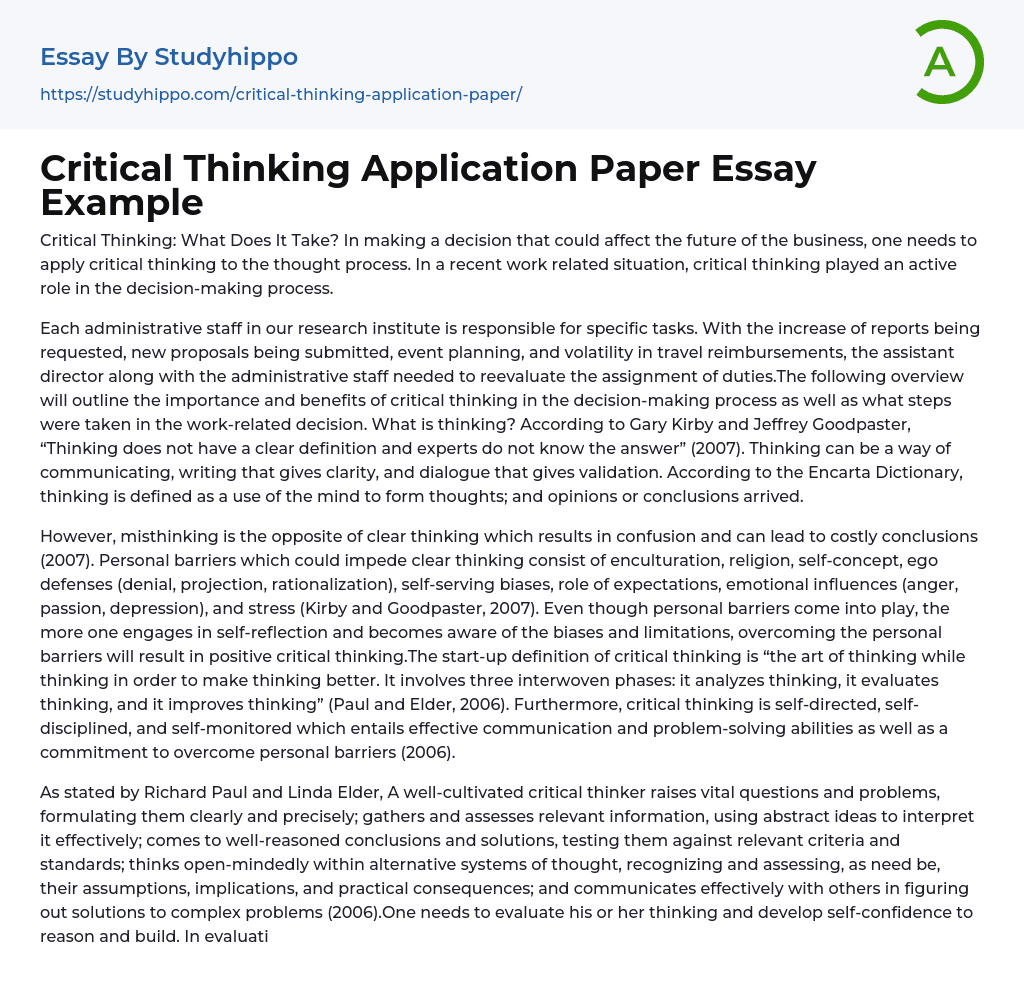Critical Thinking: What Does It Take? In making a decision that could affect the future of the business, one needs to apply critical thinking to the thought process. In a recent work related situation, critical thinking played an active role in the decision-making process.
Each administrative staff in our research institute is responsible for specific tasks. With the increase of reports being requested, new proposals being submitted, event planning, and volatility in travel reimbursements, the assistant director along with the administrative staff needed to reevaluate the assignment of duties.The following overview will outline the importance and benefits of critical thinking in the decision-making process as well as what steps were taken in the work-related decision. What is thinking? According to Gary Kirby and Jeffrey Goodpaster, “Thinking does not have a clear definition and experts do not know the answer” (2007). Thinking
...can be a way of communicating, writing that gives clarity, and dialogue that gives validation. According to the Encarta Dictionary, thinking is defined as a use of the mind to form thoughts; and opinions or conclusions arrived.
However, misthinking is the opposite of clear thinking which results in confusion and can lead to costly conclusions (2007). Personal barriers which could impede clear thinking consist of enculturation, religion, self-concept, ego defenses (denial, projection, rationalization), self-serving biases, role of expectations, emotional influences (anger, passion, depression), and stress (Kirby and Goodpaster, 2007). Even though personal barriers come into play, the more one engages in self-reflection and becomes aware of the biases and limitations, overcoming the personal barriers will result in positive critical thinking.The start-up definition of critical thinking is “the art of thinking while thinking in order to
make thinking better. It involves three interwoven phases: it analyzes thinking, it evaluates thinking, and it improves thinking” (Paul and Elder, 2006). Furthermore, critical thinking is self-directed, self-disciplined, and self-monitored which entails effective communication and problem-solving abilities as well as a commitment to overcome personal barriers (2006).
As stated by Richard Paul and Linda Elder, A well-cultivated critical thinker raises vital questions and problems, formulating them clearly and precisely; gathers and assesses relevant information, using abstract ideas to interpret it effectively; comes to well-reasoned conclusions and solutions, testing them against relevant criteria and standards; thinks open-mindedly within alternative systems of thought, recognizing and assessing, as need be, their assumptions, implications, and practical consequences; and communicates effectively with others in figuring out solutions to complex problems (2006).One needs to evaluate his or her thinking and develop self-confidence to reason and build. In evaluating the assigned tasks of the administrative staff within our research institute, several issues were raised that needed further investigation. The assistant director along with the administrative staff coordinated a list of tasks that each currently is responsible for as well as the additional tasks that are being required. Once the list was compiled, each of the administrative staff was asked to look at the tasks to determine if a reassignment of tasks would be beneficial.
Each administrative staff assessed the list by asking questions regarding the importance of each task (Example: Has event coordination caused a backlog in completing other assigned tasks? Is there a better way to coordinate the event by having a checklist to ensure all parts of the event are covered? Is there a certain time of day that tasks are scheduled
to be completed? Which tasks takes precedence over others? ). Once all relevant questions and information was received, carefully consideration was given to assign the tasks according to importance.The evaluation of reassigning tasks did not happen instantly. With the increased reports being asked by departmental administration, the assistant director has developed checklists for several processes.
Checklists have been developed for events and meetings, proposals, new center set-ups that specifically tells each administrator what part he or she is responsible for (Example: ledgers, loading, v-net code, copy code, files, transfers, personnel action form, mailbox, keys. ).The checklists provide assistance for administrators when another administrator is out of the office to determine if something is needed or has not been done. The implementation of checklists has proven to be very successful especially in event and meeting coordination.
When the administrator, who was in charge of event coordination, was absent the day of the event, the other administrators in the office were able to look at the checklist and had the information readily available to take charge of the event, in her absence.With new processes within the department as well as the university, further modifications to the assignment of tasks will be evaluated as the need arises. As administrators within the research institute, each one of us needs to take an active approach in the decision-making process by thinking critically and carefully reason through problems that may arise. In conclusion, critical thinking is crucial to the decision-making process. When making a decision for a company, one needs to look at all possible solutions before making a rash decision.Being a strong, fair-minded critical thinker could prove far more advantageous
for oneself and the company.
A critical thinker raises and formulates vital questions, communicates effectively with other personnel to come up with a viable solution not compromised by personal barriers. ? References Kirby, G. & Goodpaster, J. (2007).
Thinking. 4th Ed. Upper Saddle River, NJ: Prentice Hall. Paul, R. & Elder, L.
(2006). Critical Thinking: Tools for Taking Charge of Your Learning and Your Life. 2nd Ed. Upper Saddle River, NJ: Prentice Hall.
- Interpretation essays
- Plagiarism essays
- Analogy essays
- Learning English essays
- Coaching essays
- Critical Thinking essays
- homework essays
- Learning essays
- Library essays
- Listening essays
- Literacy essays
- Mentor essays
- Physical Education essays
- Project essays
- Reading essays
- Research essays
- Sex Education essays
- Social Studies essays
- Standardized Testing essays
- Study Plan essays
- Teaching essays
- Bias essays
- Big Five Personality Traits essays
- Body Image essays
- Mind essays
- Motivation essays
- Phobias essays
- Thought essays




